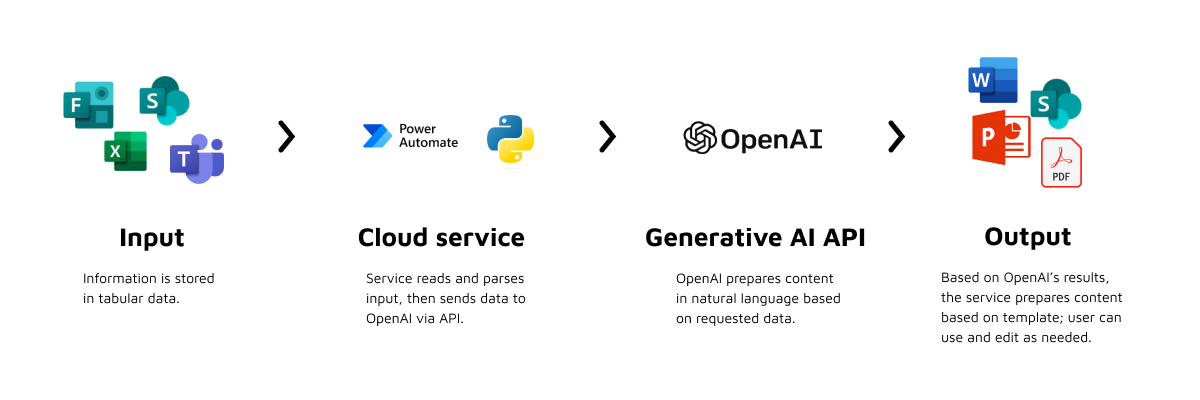What we’re currently seeing about generative AI is remarkable and awe-inspiring that many might deem it a mature innovation ready to upend the business world. It’s not. Technical, practical, and ethical issues abound, with many more unexplored implications. For organizations looking into using generative AI, decision-makers need an abundance of caution — from identifying where it can have the biggest potential in the business and implementing mechanisms to monitor it to assembling a cross-functional team that can tap into its potential.
In our previous article, we covered the fundamentals of generative AI. Here, we explore some of its use cases that can bring immediate impact to the business. We also share a real-life use case of integrating generative AI into knowledge management systems.
What can individuals and businesses do with generative AI?
This new type of AI has plenty of beneficial use cases, such as:
-
Copywriting. Apps like Jasper can create blog posts and other marketing collaterals.
-
Image and video generation. Generative AI can create realistic and stylized image and video renderings. An AI program called Midjourney can even create images from textual descriptions.
-
Assistive tech. Camera-equipped smartglasses by Envision can create audio descriptions for the blind.
-
Programming. Apps like Copilot can suggest snippets of codes for developers to use.
-
Composing music. DeepComposer can take a short melody and turn it into a complete song.
-
Medicinal drug discovery. Generative AI can virtually create potentially viable drug molecules.
-
Voice cloning. Respeecher can take recordings of a person’s voice and then create speech in that voice.
A word of caution:As with any technology, generative AI can be used to help or hurt people. A prime example of a harmful application is the creation of artificial videos called deepfakes. They are generated by an AI that combines and manipulates real images or video clips to convey events that never actually happened and show people making statements that they never actually made. Deepfakes can be used to mislead people into believing false things like fake news clips and fraudulent evidence. |
Real-life use case of generative AI: Creating content for knowledge management systems
Here’s a sample use case of applying generative AI to create content (for instance, slides on PowerPoint):

A visualization of how generative AI can be used to create content (using APIs to connect workspaces to OpenAI)
Imagine a user-submitted project information in a receptacle like SharePoint. The AI can consolidate all the information, identify the pertinent details, and craft well-written and compelling content for the user. Essentially, the app saves users time and effort and allows them to focus on more urgent tasks. The steps we developed for this are as follows:
-
The user fills up a form with information or selects project data for which the content will be generated.
-
A low-code development platform (Power Automate augmented with Python coding) parses the submitted information, then delivers the resulting data to OpenAI’s GPT-3 API.
-
OpenAI’s model generates the content that would be used for a project. The original text won’t be merely copy-pasted from the form. Rather, it creates new text that fits the parameters of the user-generated input.
-
The internal app takes the generated content and places it on the appropriate sections of a template. Users can revise the content as they see fit.
We share this use case to help you see the bigger picture we have in mind: applying generative AI on knowledge management systems.
Generative AI in knowledge management
A knowledge management system helps users access and use information internally. The basic processes behind knowledge management involves the following:
Knowledge acquisition and creation: The organization accumulates information by obtaining it from internal sources (such as employees sending out customer surveys) and external sources (such as third-party experts providing skills training). It is at this stage that metadata can be added onto the information, such as:
-
What the knowledge is for.
-
How the knowledge will be applied.
-
Where it will be applied.
Knowledge organization: Knowledge is structured so that authorized users can easily retrieve it, but at the same time, it is secured so that unauthorized parties can never access it.
Knowledge sharing: Knowledge is imparted (for example, during employee training), submitted to relevant parties (such as providing carbon emissions reports to regulators), exchanged among users, and enhanced via discussions. The content and the medium used to convey knowledge can vary depending on what is being shared and to whom it is being shared to.
As you can imagine, generating content from user-submitted information is but a taste of what generative AI can do with a knowledge management system. Currently, when users retrieve information from systems like SharePoint, those systems use search engines that provide keyword search results that are sorted by how relevant they are to the keywords provided. The user must scroll through the results and open them to see if they indeed contain the information they need.
A generative AI-powered system, on the other hand, can:
-
Provide summaries of content based on search results.
-
Explain the relevance of the results to the one searching, given parameters such as the searcher’s role in the organization.
And, as we’ve illustrated earlier, the AI can also create all sorts of things that are based on the relevant information stored in your knowledge management system.
By taking advantage of APIs to connect various workspaces, platforms, and systems, a generative AI-powered program can create content for assets like the following:
-
Progress reports
-
Financial reports
-
Sustainability reports
-
User manuals
-
Process flowcharts
-
Technical requirements documents
-
UX research reports
-
Marketing reports
-
Newsletters
-
Survey reports
-
White papers
-
Case studies
In addition to creating text, generative AI can also include data visualizations and pictures drawn from text descriptions. It can also incorporate parameters such as document layouts, reporting frameworks and standards, and profiles of intended audiences.
In short, enterprises can delegate the creation of such documents to an AI program so that human knowledge workers can spend more time on higher-value tasks. And as companies like yours create more and more data, even the most well-built knowledge management systems can become unwieldy over time. Having the AI do the data parsing and content generation for you will likely prove beneficial for your organization.
Indeed, generative AI can perform feats that can disrupt the business, what with its ability to learn, augment data, and generate new and unique outputs. While eagerness, interest, and optimism are warranted, caution and prudence are required. In our next article, we’ll tackle the caveats and challenges of using generative AI, and how businesses can responsibly harness its potential while steering clear of its risks.
Generative AI at Lingaro
We see the availability of large language models (LLMs) like GPT to produce good and reasonable semantic artifacts at a mass scale. Lingaro’s Intelligent Insights solution, for instance, provides content (e.g., summaries, guides, reports, comments) that can be personalized and presented in the right business context for increased comprehension and high adoption.
Using generative AI to craft a message out of raw insights, customizing it to the users’ contexts, and then delivering it to their points of consumption will allow our customers to spend more time on perfecting their business operations. The important factor is understanding the underlying architecture of the models. We see the importance of intelligent prompting from a security and governance standpoint, but we also recognize the potential of using the capabilities of LLMs to their full extent. While working on Intelligent Insights and using the transformative capabilities of generative AI, Lingaro focused on flexibility for the users to combine stories in forms that are both relevant (based on machine-learned understanding of user affinity) and potentially emotionally resonant for the person to whom the story is delivered.
We don’t see GPT-3 as a replacement of human intelligence, but rather a new way of interacting with the insights that are produced with our data services. It’s important to create a safe environment for the user. The primary application of models like GPT-3 will help us with automating small tasks like reconstructing missing parts of texts or completing them.
Read more articles on generative AI:








.png?width=528&height=313&name=1546%20Blog%20Covers%2c%20Article%20From%20the%20Business%20Insider%20old2-(Compressify.io).png)